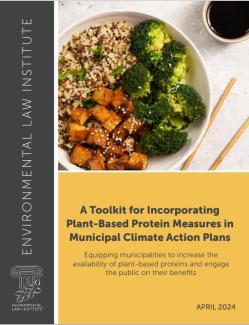Thousands of cities have joined initiatives such as the Global Covenant of Mayors for Climate and Energy, pledging to reduce their carbon footprints. Cities are pursuing a range of actions to reach their targets but until recently have largely ignored measures to advance plant-based proteins — despite the conclusion of the Intergovernmental Panel on Climate Change and other experts that reducing meat consumption plays a key role in addressing climate change.
Recently, however, municipalities are paying more attention to the mitigation potential of plant-based proteins — not only in their climate action plans but in other governance tools as well. Measures range from procurement practices to Meatless Monday campaigns to education and outreach.
This trend coincides with the rollout of what the Good Food Institute calls the “next-generation of plant-based meat,” which “looks, cooks, and tastes like conventional meat.” These products, which “biomimic” meat, appeal to most consumers and are being successfully marketed in stores and restaurants.
The climate mitigation payoff can be substantial. Life-cycle assessments find that the Impossible Burger and its competitor the Beyond Burger stack up well against their beef counterpart — with 89 percent less greenhouse gas emissions. Even small adjustments can be significant. According to the Green Cincinnati Plan: “If 10 percent of Cincinnatians ate meat one less day per week . . . [carbon] emissions would be reduced by 75,000 tons per year.”
Cost-savings are also a factor. A Friends of the Earth study finds that the Oakland Unified School District “slashed the carbon footprint of its food service 14 percent by reducing its purchases of animal products by 30 percent and replacing them with plant-based proteins and more fruits and vegetables.” In addition, there are substantial health benefits in eating less meat.
Nevertheless, cities have been slow to promote plant-based proteins in part because of the practical and political challenges associated with convincing residents to change their diets. The global sustainability organization ICLEI USA’s Angie Fyfe notes that it is “really hard to impose restrictions on diets” and flags “the perils of dictating what people can eat,” citing former New York City Mayor Bloomberg’s efforts to ban large sugary drinks. As a result, she observes that cities tend to “look to options that incentivize” rather than mandate changes.
To be sure, it is easier for cities to introduce plant-based proteins in their own operations, such as hospitals and prisons. However, emissions associated with food consumption are not typically considered in calculating a city’s carbon footprint — unless the food is produced within its geographic boundaries. Because meat is not commonly produced in cities, municipalities may be more likely to focus on reducing the emissions they are required to report.
Despite these barriers, cities are moving forward — driven in part by cost savings, public health, and sustainability goals. Among their approaches is exercising the power of the purse. In their Municipal Guide to Climate-Friendly Food Purchasing, FOE and the Responsible Purchasing Network emphasize that procuring less meat in operations is “a triple win for community well-being, local budgets, and the planet”— and can also motivate the private sector to take similar actions.
According to the guide, several municipalities include “climate friendly food procurement” measures in their climate action plans, including Portland and Eugene, and some specifically address reduced meat consumption, such as Santa Monica (15 percent reduction target for meat and dairy purchases) and Carrboro (50 percent target for emissions reductions associated with meat consumption). And cities like Boulder, Portland, San Diego, and Philadelphia provide guidance on offering plant-based meat alternatives at municipal facilities.
Procurement standards for plant-based proteins also can be incorporated into broader sustainable purchasing and healthy food standards. For example, numerous cities follow the Good Food Purchasing Program’s environmental sustainability and animal welfare standards, which include a strategy to promote “plant-forward menus” with smaller portions of animal proteins.
In addition, a large number of municipalities, and in some cases their school districts, are adopting various forms of Meatless Monday campaigns pursuant to proclamations, resolutions, policies, and climate action plans.
Education and outreach initiatives are also common. Iowa City’s climate action plan supports efforts to promote the benefits of a “plant-rich diet” and Carrboro’s plan includes outreach to residents on climate-friendly diets.
Innovative governance measures to advance plant-based proteins, coupled with omnivore-friendly products, may mark an inflection point in addressing a seemingly intractable climate mitigation challenge.


